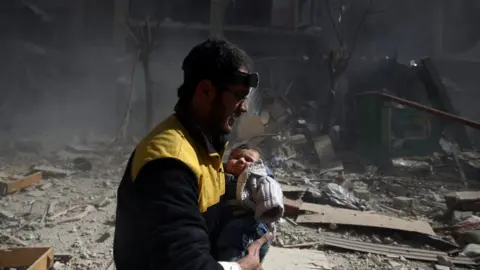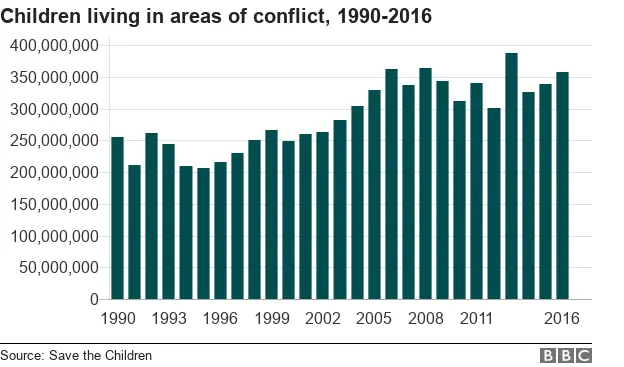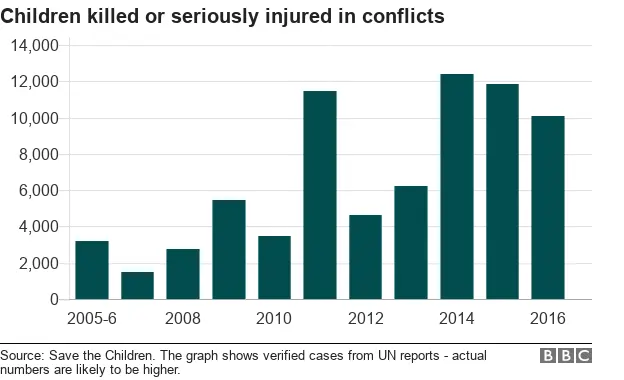One in six children 'affected by conflict' - Save the Children
 Reuters
ReutersOne in every six children are now living in a global conflict zone, a new report by Save the Children claims.
Children are at more risk from armed conflict now than at any other time in the last 20 years, the charity says.
Its new analysis found more than 357 million children were living in a conflict zone - an increase of 75% from the 200 million of 1995.
Syria, Afghanistan and Somalia were ranked as the most dangerous places for children.
In general, children in the Middle East were most likely to live in a conflict zone, where two in every five lived within 50km of the site of a battle or other fatal attack. Africa was ranked second, at one in five.
Just under half of at-risk children - some 165 million - were classified as living in "high-intensity" conflict zones.
Those children are at risk of all six of what the United Nations calls "grave violations":
- killing and maiming
- recruitment and use of children
- sexual violence
- abduction
- attacks on schools and hospitals
- denial of humanitarian access
Save the Children used UN and other research data in its report, but criticised "huge gaps" in the scope of data recorded by forces at war with one another.
Despite its concerns, it said there was still a 300% increase in the number of children killed and maimed since 2010, according to a record of incidents verified by the UN.

Part of the reason for the increase in the number of children living in dangerous areas is due to an "increasing trend" of urban warfare in towns and cities, it said, plus a recent trend of long and complicated armed conflicts.
Deliberate humanitarian blockades by extremist groups and long-term sieges in countries such as Yemen and Syria are also to blame.
"Siege tactics and starvation tactics are also increasingly being used as a weapon of war against civilians, to try to force an armed group or whole community to surrender," the report says.
Attacks on hospitals and schools, it said, have become the "new normal".
Save the Children says that despite improved international legal standards to protect children, "increasingly brutal tactics are being utilised" by actors around the world.
That includes the use of recruitment child soldiers, and sexual violence against children - which it says is largely unknown because of a reluctance to report sexual abuse.
And while the use of some weapons known to have killed and maimed children - such as chemical weapons, landmines and cluster bombs - has reduced, other threats remain.
It cited the use of child suicide bombers and the widespread continued use of weapons like barrel bombs and improvised explosive devices (IEDs), which kill soldiers and civilians indiscriminately.

In addition to the risk of injury or death, children in affected regions often lack basic sanitation, education, and suffer from malnutrition.
"Children are suffering things that no child ever should; from sexual violence to being used as suicide bombers," CEO Helle Thorning Schmidt said. "Their homes, schools and playgrounds have become battlefields."
"Crimes like this against children are the darkest kind of abuse imaginable, and are a flagrant violation of international law," she added, calling on world leaders to do more.
The report, titled The War on Children, is based on research carried out by Save the Children and the Peace Research Institute Oslo (PRIO), looking at trends in international violence from 1995-2016.
Data from 2017 is incomplete, so recent escalations such in places such as Myanmar are not fully reflected.
The report was released ahead of the influential Munich Security Conference, which begins on Friday and which the charity says is an opportunity for global leaders to agree on measures to protect children.
